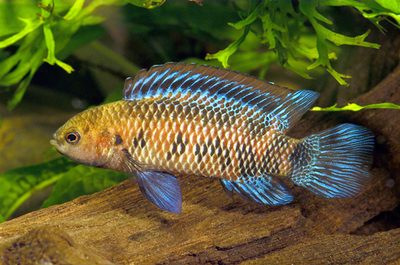Badis (Badis badis)
From The Aquarium Wiki
(Redirected from Dwarf Chameleon Fish)
Badis
Badis badis
76 Litres (20 US G.)
5.1-7.6cm (2-3 ")
Freshwater
6.0 - 8.0
23 -26 °C (73.4-78.8°F)
5-19 °d
1:1 M:F
3-5 years
Family
Badidae
Contents
Additional names
- Badis, Blue Perch, Dwarf Chameleon Fish
Additional scientific names
- Labrus badis, Badis buchanani, Cychla fasciata, Labrus fasciata
Origin[edit]
- This fish is native across various ponds, rivers, swamps and drainage ditches from the Ganges River drainage in India, Bangladesh, and Nepal, from Himachal Pradesh (Yamuna River) to the estuary; the Mahanadi River drainage; Assam lowlands close to Brahmaputra (Kaziranga, Gauhati, and Dibru River). Also reported from Bhutan and Pakistan
Sexing[edit]
- Males are deeper in colour and are slimmer.
Breeding[edit]
- The pair should be separated, and conditioned on various live foods, such as tubifex, white worm, etc. A flower pot with the bottom removed or something similar should be provided for the pair to spawn in. The male will chase the female quite passionately, and she should be provided lots of cover.
Tank compatibility[edit]
- This fish may be kept in community tanks with carefully selected tank mates. At can at first seem shy but as it becomes more bold in it's surroundings may become aggressive. It should therefore not be kept with smaller fish nor long-finned fish. Robust similar-sized fish that are not too boisterous should be suitable.
Diet[edit]
- Prefers live/frozen food such as brine shrimp and bloodworm. May take flake or pellet food once it's settled into the tank.
Feeding regime[edit]
- Feed once or twice a day. They will accept food from the surface after observing it awhile but prefer it to sink to the bottom where they normally reside. They may be out-competed to food by faster swimming fish.
Environment specifics[edit]
- Provide a spacious mature tank with plenty of hiding places to hide in bogwood, dense planting and rock work. They prefer either small rounded gravel or sand substrate.
Behaviour[edit]
- They are rather shy even though they are territorial at times, especially once they are established in an aquarium.
Identification[edit]
- n elongated, oval-shaped species with slight lateral compression with a small mouth. The caudal fin in fan-shaped while the dorsal fin runs from above the pectoral fin to the caudal peduncle and may be very elongate depending on the fish. Healthy males have a brownish-red back with with raspberry to red to blue flanks. The flanks are marked with red, yellow, and/or blue spots. The lower parts are orange to green. A black stripe extends from the mouth, through the eye, to the base of the dorsal fin. The dorsal fin is reddish and marked with green or red horizontal stripes.The other fins vary from blue to red in colour.
Pictures[edit]
Videos[edit]
External links[edit]
- Fishbase (Mirrors:
 )
)

